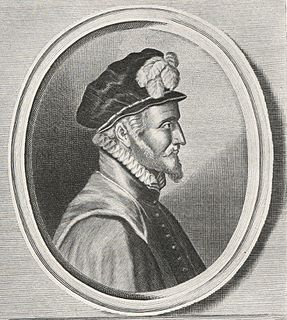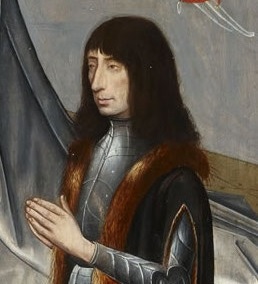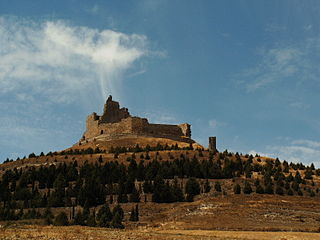Sources
- Pinilla González, Jaime (1978). El arte de los Monasterios y Conventos despoblados de la provincia de Salamanca. Salamanca: Ediciones Universidad de Salamanca.
San Leonardo de Alba de Tormes was a monastery near Alba de Tormes in Spain. It was suppressed in the 19th century. [1]
The date of San Leonardo's foundation is uncertain. It may be referred to in the fuero given to Alba de Tormes in 1140, although the latter only mentions a garden named San Leonardo. [1] The monastery was founded as a mixed Praemonstratensian community of monks and nuns, most likely in 1154 by the Emperor Alfonso VII. [1] Alfonso granted the lordship of Alba de Tormes to Sancho, the abbot of Retuerta, the father house of San Leonardo. [1] In 1164 the nuns were removed and the foundation became male-only. [2] In 1168 some monks from San Leonardo left to found the monastery of La Caridad in Ciudad Rodrigo. [2] The house of San Miguel de Groz in Portugal was also a product of San Leonardo until it was absorbed back into it as a dependency in the fourteenth or fifteenth century. [2] The convent of Santa Sofía de Toro was probably a daughter house, since its necrology lists many of the abbots of San Leonardo. [2] One abbot, Fernando, attended the Council of Basel in 1434 as part of the Spanish Praemonstratensian delegation. [2]
In 1439, on account of the relaxed discipline prevailing there, San Leonardo was turned over to the Hieronymites by the archbishop Gutierre Álvarez de Toledo, who was also lord of Alba. Sources disagree whether he was acting on orders from Pope Eugene IV, or on his own initiative. [2] The historian of the Hieronymites, José de Sigüenza, cited a papal bull of 2 February 1442 authorising a new foundation with Hieronymites from the monastery of Montamarta. [2] In 1446 the transfer was confirmed by a bull of Nicholas IV, now in the national archives. [3] The ceremony was performed by the archdeacon of Medina on 7 November 1447 in the presence of Fernando Álvarez de Toledo, the first count of Alba. [3] Numerous members of the House of Alba were eventually buried in San Leonardo. [3]

Fernando Álvarez de Toledo y Pimentel, 3rd Duke of Alba, known as the Grand Duke of Alba in Spain and Portugal and as the Iron Duke in the Netherlands, was a Spaniard noble, general and diplomat. He was titled the 3rd Duke of Alba de Tormes, 4th Marquess of Coria, 3rd Count of Salvatierra de Tormes, 2nd Count of Piedrahita, 8th Lord of Valdecorneja, Grandee of Spain and a Knight of the Order of the Golden Fleece. His motto in Latin was Deo patrum nostrorum.

The Order of Saint Jerome or Hieronymites is a Catholic cloistered religious order and a common name for several congregations of hermit monks living according to the Rule of Saint Augustine, though the role principle of their lives is the 5th-century hermit and biblical scholar Jerome.
Alfonso of León, Lord of Molina was an infante (prince) of León and Castile, the son of King Alfonso IX of León and his second wife Queen Berengaria of Castile. He was the brother of King Ferdinand III of Castile and León, and father of Queen Maria of Molina, wife of King Sancho IV. He became Lord of Molina and Mesa after his first marriage to Mafalda González de Lara, the heiress of those lands.

The House of Alba de Tormes, commonly known as the House of Alba, is a prominent Spanish noble family that descended from 12th-century nobility of post-conquest Toledo. The family's claim to Alba de Tormes dates from 1429, when Gutierre Álvarez de Toledo became Lord of Alba de Tormes while serving as Bishop of Palencia.

Fadrique Álvarez de Toledo y Enríquez de Guzmán, 4th Duke of Alba, Grandee of Spain,, , was a commander in the Spanish army during the Eighty Years' War.

Duke of Alba de Tormes, commonly known as Duke of Alba, is a title of Spanish nobility that is accompanied by the dignity of Grandee of Spain. In 1472, the title of Count of Alba de Tormes, inherited by García Álvarez de Toledo, was elevated to the title of Duke of Alba de Tormes by King Henry IV of Castile.

Alba de Tormes is a municipality in the province of Salamanca, western Spain, part of the autonomous community of Castile and León. The town is on the River Tormes upstream from the city of Salamanca. Alba gave its name to one of Spain's most important dukedoms, who had their ancestral seat in the Castillo de los Duques de Alba. St Teresa of Ávila died at a convent she founded in the town and is buried there.

The Roman Catholic Archdiocese of Burgos is one of Spain's Latin Metropolitan sees.

García Álvarez de Toledo y Carrillo de Toledo, 1st Duke of Alba de Tormes was a Spanish nobleman, military leader and politician, whose family had presided over the lands of Alba since the year 1369.

Antonio Álvarez de Toledo y Beaumont, 5th Duke of Alba, Grandee of Spain,, was a Spanish nobleman and politician.

Nuño Pérez de Lara was a Castilian nobleman, politician and military leader. He began his career at the court of the Emperor Alfonso VII, during whose reign he took part in the repoblación of the Extremadura and the defence of the Almohad frontier. Between 1164 and 1169 he governed Castile as regent for the underage Alfonso VIII, and he continued to exercise semi-regal power in the kingdom until 1176. He founded two monasteries and fostered the cult of Thomas Becket in Spain. He died taking part in the Reconquista of Cuenca.

The Castle of San Servando is a medieval castle in Toledo, Spain, near the Tagus River. It was begun as a monastery, occupied first by monks and later by the Knights Templar.

Hernando de Talavera, O.S.H. was a Spanish clergyman and councilor to Queen Isabel of Castile. He began his career as a monk of the Order of Saint Jerome, was appointed the queen's confessor and with her support and patronage, became the Archbishop of Granada.
Monasteries in Spain have a rich artistic and cultural tradition, and serve as testament to Spain's religious history and political-military history, from the Visigothic Period to the Middle Ages. The monasteries played an important role in the recruitment conducted by Christian aristocracy during and after the progress of the Reconquista, with the consequent decline in the Muslim south of the peninsula.
The Mayordomo mayor was the Officer of the Royal Household and Heritage of the Crown of Spain in charge of the person and rooms of the King of Spain. The Office of “Mayordomo mayor” was suppressed after the proclamation of the Second Spanish Republic in 1931 and never re-created after the restoration of the Monarchy in 1975, but it can be said that it is the historical precedent of the modern Head of the Royal Household of Spain.

The Convento de Santa Clara la Real is a convent of the Poor Clares located in the city of Toledo, Castile-La Mancha, Spain. The present convent was founded in the middle of the 14th century by Toledan noblewoman María Meléndez, and is located near other monasteries of note, such as the monastery of Santo Domingo el Real and the Convent of Capuchins of Toledo.

Castillo de los Duques de Alba is a castle-palace in Alba de Tormes, Salamanca province, western Spain. It is the ancestral seat of the House of Alba. Today, the castle is in ruins and can be visited by the public.

Gonzalo de Illescas was a Hieronymite monk, an advisor to King John II of Castile from 1435 until 1454 and the bishop of Córdoba from 1454 until his death.